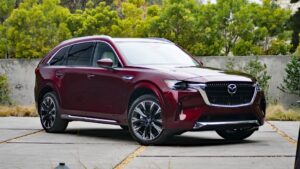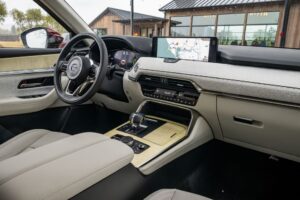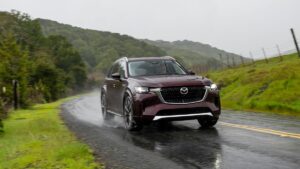The all-new mid-sizer has all the goodies you’d expect in a premium SUV except for a luxury-brand badge.
The whole reason the three-row crossover SUV exists is because Americans no longer wanted to be seen in minivans. It’s true. Vehicles like the original Chrysler Pacifica and Honda Pilot had their minivan architectures manipulated to look like big, thirsty truck-based SUVs while still functioning much like their respective Town & Country and Odyssey counterparts. Although the Pacifica and Pilot were jacks-of-all-trades and masters of none, they’d go on to spur the proliferation of a massive segment that 20 years on includes no fewer than a dozen options. Yet most of those options still suffer from the same drawbacks of the segment’s Adam and Eve. If our first spin in the new 2024 Mazda CX-90 is any indication, it won’t be one of them. But that’s not to say there aren’t some major drawbacks to Mazda’s new premium people mover.
New From the Ground Up
 Mazda says that the CX-90 will serve as its flagship, and the company clearly has taken that mission seriously. This is no remake of an existing product. The CX-90 is built on an all-new architecture, is powered by two all-new engines—one of them a plug-in hybrid—and sends its power through an all-new transmission to a new all-wheel-drive system. The CX-90 sits on what Mazda calls its Large platform. By any other name, it’s a rear-drive architecture that situates the engine longitudinally rather than transversely as it is in the CX-9 and all other Mazda products, save for the Miata. All CX-90s come with all-wheel drive standard.
Mazda says that the CX-90 will serve as its flagship, and the company clearly has taken that mission seriously. This is no remake of an existing product. The CX-90 is built on an all-new architecture, is powered by two all-new engines—one of them a plug-in hybrid—and sends its power through an all-new transmission to a new all-wheel-drive system. The CX-90 sits on what Mazda calls its Large platform. By any other name, it’s a rear-drive architecture that situates the engine longitudinally rather than transversely as it is in the CX-9 and all other Mazda products, save for the Miata. All CX-90s come with all-wheel drive standard.
The new underpinnings have another purpose: They enable the CX-90 to look the part of the premium SUV it’s trying to be. That’s thanks to a longer dash-to-axle ratio—the distance from the front wheels to the dashboard—something not achievable with a transverse-engine, front-drive layout. The result is a longer hood and a cabin that sits farther back. It’s a more elegant proportion, one employed on luxury vehicles from BMWs to Benzes.
Carefully tailored sheetmetal with handsome detailing dresses that premium profile. The CX-90 looks substantial, but it’s actually only slightly bigger on the outside than the CX-9 that it will replace at the end of 2023—1.4 inches longer, 0.6 inch taller, and 1.0 inch wider. Its 200.8-inch overall length and long 122.8-inch wheelbase put its exterior size at the larger end of the broad mid-size-SUV segment, which encompasses everything from the Kia Telluride to the Toyota 4Runner. The CX-90’s one big size difference compared with the outgoing CX-9 is its wheelbase, which is 7.5 inches longer.
Three CX-90 Models
CX-90s come in three models: Turbo, Turbo S, and PHEV (plug-in hybrid). The first two are powered by an engine that helps the CX-90 feel like the real deal: a 3.3-litre turbocharged inline-six with a 48-volt, 17-hp hybrid-assist system. A 280-hp version of the engine with 332-pound feet of torque powers the Turbo; this version runs on regular fuel. A 340-hp version of the six making 369 pound-feet of torque on premium fuel motivates the Turbo S. Both engines’ internals are identical; Mazda turns up the boost on the more powerful variant by roughly 5 psi to about 19 psi and adjusts other engine parameters to take advantage of higher-octane fuel. The plug-in hybrid mates a 189-hp 2.5-liter turbo four with a 173-hp electric motor for a combined 323 horsepower and 369 pound-feet of torque, also on premium fuel. Both the 48-volt hybrid-assist motor and the plug-in’s more powerful electric motor are sandwiched between the engine and the eight-speed automatic. Mazda’s first automatic with more than six forward speeds, it was developed entirely in-house. Mazda chose to use a wet clutch pack in place of a conventional torque converter; this arrangement is more compact, which slims the transmission’s size and opens up additional foot room for front-seat passengers by reducing the width of the transmission tunnel.
More Refined And More Fun
From behind the wheel, the 2024 CX-90 picks up where the CX-9 left off, elevating the playful loveliness of the CX-9 into a more dynamically refined vehicle. Steering is heavy on-center—especially with standard lane keep assist on—but it lightens up gently off-center, linearly weighing up as you dig into a corner. The firm but forgiving ride helps the CX-90 load up naturally in corners without devolving to body roll, allowing the driver to lightly brush the brake pedal to put more weight on the big crossover’s nose for even more immediate turn-in. Few SUVs in the CX-90’s class are going to be able to hang with it on a twisty back road. Dynamically, the differences between the I-6 and PHEV model are subtle; the plug-in feels slightly heavier, but it’s not enough to really matter if you’re choosing between the two.
On the powertrain front, Mazda reps described the choice between the Turbo S and PHEV models as choosing between delayed and instant gratification. That analogy generally holds up. The new I-6 is the type of engine that’s going to make the discerning enthusiast swoon. Thanks to the torque fill provided by the motor, which reaches its 113-lb-ft peak at just 200 rpm, there’s no real lag to speak of from the turbocharged engine by the time it hits peak torque at 2,000 rpm. The spunky and smooth-revving engine feels naturally aspirated in its response to throttle inputs and really rewards drivers who ride the tach needle past 4,000 rpm. Oh, and it has one of the best exhaust notes we’ve heard from a three-row family crossover this side of a Dodge Durango Hellcat. The eight-speed and I-6 pairing is a good one, too. The transmission shifts smartly and quickly, generally doing its best to disappear into the background.
The CX-90 PHEV isn’t quite as cohesive as the I-6, though it’s still quite good. With a full charge, the plug-in hybrid model’s default drive mode favoUrs the electric motor, shuffling its power through the eight-speed auto as the three-row gets well into highway speeds. Dip about three-quarters deep into the throttle to shoot a gap or pass slower traffic, and there’s a noticeable delay as the four-cylinder fires up and some shift shock as the eight-speed downshifts. Similarly configured PHEV systems, like the one found in the Jeep Grand Cherokee 4xe, generally accomplish the same task without being quite as jerky. Switching the CX-90 into its EV mode (it can also be set as the default through the infotainment system) nets the driver more of an electron buffer before the engine fires up, though the jerkiness remains.
Despite that, the CX-90 PHEV ought to appeal both to enthusiasts who love low-end torque and to consumers who worry about little more than get-up-and-go. The torquey electric motor makes this version of the CX-90 feel quicker than the I-6 version, and depressing the gas pedal past the kick-down point results in a “Boost” message on the instrument cluster and a surge of power as the throaty four-cylinder screams and the motor’s power surges.
Interior Is Better, Not Much Bigger
 Inside, the loaded CX-90s Mazda had on hand came dressed to impress. The tech-forward cabin features a 12.3-inch infotainment display (lower-end models get a 10.25-inch version) and a crisp 12.3-inch digital instrument cluster (some lesser models use analog gauges). Fit and finish are top notch, though materials quality—while superb for a mainstream automaker—likely won’t make the luxury automakers that Mazda wants to compete with sweat much.
Inside, the loaded CX-90s Mazda had on hand came dressed to impress. The tech-forward cabin features a 12.3-inch infotainment display (lower-end models get a 10.25-inch version) and a crisp 12.3-inch digital instrument cluster (some lesser models use analog gauges). Fit and finish are top notch, though materials quality—while superb for a mainstream automaker—likely won’t make the luxury automakers that Mazda wants to compete with sweat much.
Mainstream automakers aren’t likely to lose much sleep over the CX-90’s packaging, either, even though it’s available in six- (in a 2-2-2 arrangement, front to back), seven- (2-2-3), and eight-seat (2-3-3) configurations. Simply put, although the CX-90 is bigger than the CX-9 it’s replacing, its accommodations aren’t quite as generous as those of the Telluride, Hyundai Palisade, or new Pilot. Where Mazda made the biggest improvements are in the first and third rows. Up front, the new center console is more logically arranged and features a deeper bin and more storage—despite the wasted, black-plastic-trim-clad space surrounding Mazda’s new electronic shifter.
The second row for all intents and purposes features identical specs to the CX-9. The outboard seats are relatively adult-friendly, but the massive driveshaft hump splitting the cabin eats into foot room for the outboard seats while also making the middle seat functionally useless for anything larger than a Labrador. Second-row occupants do get their own HVAC vents and water bottle pockets in the doors, and the PHEV on hand also featured a flip-up mini cupholder/table combo—though it didn’t exactly inspire confidence in how well it holds drinks. Our I-6-powered test SUV had a second-row console like the CX-9 offered, which featured more robust cupholders, a slide-out drawer, and a console cubby.
Access the third row by grabbing the shoulder-mounted latch (easy) or squeezing between the second-row captain’s chairs (difficult), and your sassiest child can wedge into either of the outboard seats to enjoy the two cupholders per side. On all but base models, there’s also a USB-C port to keep their pocket-borne distractions charged up. The middle seat in the third row is best forgotten; due to the high floor and low roofline of our two sunroof-equipped models, we’re skeptical of its utility for all but the smallest of hominids.
On the plus side, both second and third rows easily fold flat to expand the CX-90’s cargo hold, and although cargo volume with the third row in place is still far from best-in-class, the up to 15.9 cubic feet on offer bests the old CX-9’s 14.4. In real-world terms, the CX-90 will likely swallow at least a half-dozen brown paper grocery bags.
 If this all sounds familiar, well, yeah, it kind of is. The new CX-90 is even better to drive than the CX-9, but it still suffers from many of the same packaging problems as its predecessor. This first drive of the CX-90 leaves us feeling very good about Mazda’s latest push toward luxe. This SUV is handsome, plush, and value-priced relative to the premium vehicles it aspires to compete against. It drives with just the right balance of sportiness and refinement to be both engaging and appropriately cosseting. It looks sharp outside and is well appointed inside. But will the general public buy into the premise of Mazda’s master’s thesis—that a brand with a mainstream badge on the grille has the chops to compete with premium SUVs? With CX-90s hitting dealerships in the next few weeks, we’ll know soon enough.
If this all sounds familiar, well, yeah, it kind of is. The new CX-90 is even better to drive than the CX-9, but it still suffers from many of the same packaging problems as its predecessor. This first drive of the CX-90 leaves us feeling very good about Mazda’s latest push toward luxe. This SUV is handsome, plush, and value-priced relative to the premium vehicles it aspires to compete against. It drives with just the right balance of sportiness and refinement to be both engaging and appropriately cosseting. It looks sharp outside and is well appointed inside. But will the general public buy into the premise of Mazda’s master’s thesis—that a brand with a mainstream badge on the grille has the chops to compete with premium SUVs? With CX-90s hitting dealerships in the next few weeks, we’ll know soon enough.
| 2023 Mazda CX-90 specifications | ||
| BASE PRICE | $40,970-$61,920 | |
| LAYOUT | Front-engine/front-engine + elec motor, AWD, 6-8-pass, 4-door SUV | |
| ENGINES | 3.0L/280-340hp/332-369-lb-ft turbo DOHC 24-valve I-6 plus 17-hp/113-lb-ft electric motor, 280-340/332-369 lb-ft comb; 2.5L/189-hp/192-lb-ft DOHC 16-valve I-4 plus 173-hp/199-lb-ft electric motor, 323-hp/369-lb-ft comb |




